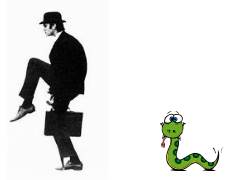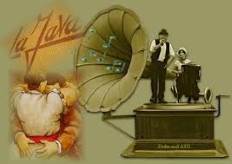Origin of programming language names
Python does not belong to the snake, but Pearl does well to the pearl, Pearl in English. Here is a list of the most famous names and their origins.
The choice of name is not always in great demand. Example APL stands for A Programming Language, while PL/1 stands for Programming Language # 1. But other names have somewhat unexpected origins...
Hell
In honor of Ada Lovelace, perhaps the first person to program a computer - Babbage's analytical machine. She left notes describing a general-purpose algorithm capable of running on a modern computer.

AWK
This language is intended for data extraction and reporting from texts dated 1977. It is an acronym for Aho, Weinberger, Kernigan (Brian). The latter is also one of the creators of Unix and co-authored textbook C.
B and BCPL
Basic Combined Programming Language was created in 1966 in Cambridge by Martin Richards. The name was subsequently shortened to B, and this will be the beginning of a long series of languages in one letter or in an embrace ..
It was a simplified version of CPL (Combined Programming Language), intended to simplify compilation, which contributed to its most widespread adoption.
C
Dennis Ritchie invented this language, derived from BCPL, to implement a Unix system. Received the name "New B" before renaming to C, the next letter B in the alphabet.
C++
First Bjarne Strustrup called this language "C with classes," then "New C," but this led to C being called "old C," which did not please C programmers.
The name C++ was then proposed to Strostrup, referring to the C increment operator: this is an increment of the C. This time it could not but please C programmers who adore cabalistic characters.
Darth
Created by Google in 2013, originally to replace JavaScript - but the goal has changed since then. It was to be called Dash, meaning "tiret," possibly alluding to # de C #, and then the word Dart (dark or dart in French) was chosen because it speaks of lightness and speed.

Erlang
It was created in 1986 by Ericsson, from where ERicsson LANGage was created. But it also comes from Agner Krarup Erlang, a Danish mathematician who created the analysis of the telephone network, the activity of Eriksson.
Java
James Gosling in 1995 named his language D for the first time to mean that he succeeded C. But he was reminded that D is the worst grade on the school ballot in American schools, so he renamed the language Oak (oak), as he saw an oak tree from his office window. Fortunately, Sun colleagues noted to him that such language already exists and another had to be found. Imagine how many programmers would call acorns!
A list of possible names was compiled, among which the team chose Java (which is synonymous with coffee in English) because everyone drinks coffee.
JavaScript
Brendan Eich, a Netscape employee who also loved coffee and the Java language, named his language Mokhoi (moka, milk coffee and chocolate) in December 1995, and then changed the name to LiveScript (live script) to celebrate its dynamic side. Since Netcape was also adding the Java language to its browser at the time, it was renamed JavaScript. Confusion between the two languages still persists among beginners .
Pascal
Nicklaus Wirth contributed to the creation of the Algol language, and then created his own version of Algol W (like Wirth). But he wanted a language that was easy to compose also in 1970 he made a more static version, which he named Pascal after the mathematician Blaise Pascal, the inventor of the first computer, Pascalin .
Pearl
Australian Larry Wall wanted to give his language a positive touch and chose Pearl (pearl). Pearl oyster culture is a specialty of Australia. Language was a pearl in his mind, the opinion of not all programmers. But there was already a language with that name, so it had to be changed, and he shortened it to Perl.
Subsequently, various abbreviations were invented to explain the name, but not related to its actual origin.
PHP
Rasmus Lerdorf had no idea that the language he came up with for his own use would become (unfortunately) so popular: it was originally an acronym for Personal Home Page!
The developers who created the commercial company running the language subsequently renamed it PHP Hypertext Preprocessor to avoid this amateur connotation.
Python
Guido van Rossum was a fan of Monty Python's Flying Circus television series, so he chose the Python name in 1991 for his language derived from the ABC scripting language. But it was the snake that most noted the perfume and we saw the appearance of an IDE for Python named Boa constructor (boa constrictor).
In the end, the creator of the language refused to explain that Python does not represent the snake and even adopted the image of the snake (subsequently stylized) as a logo.
Ruby
Yukihiro Matsumoto was a user of Perl and Python. He wanted to create a language that has the capabilities of the former and the simplicity of the latter, and is object-oriented. This, too, was supposed to be a jewel and Ruby (Rubin) was offered to him by a friend.
Rust
The final version of this Mozilla language appears in 2015 (its development began in 2006) without an official explanation, when on behalf of the authors, not even in the FAQ. Rust is French for "rust." This is not the name I would like to give the language, especially if you are creating a browser whose interface is called "chrome"! Unless the company has a red dinosaur logo, and its navigator has a fox logo whose color... redhead!
But it is also the name of the mushroom and the fact is that this language is a little psychedelic .
Smoltalk
Alan Kay created the language in 1972 (year C) with other researchers with a desire to make programming natural and human. "Small Talk" translates as "banality" with the idea that programming is a common activity, accessible even to children.
Swift
Launched in 2014 by Apple to develop on its computers and mobile devices, its name translates as "nimble." He wants to make programming more flexible, interactive.
See also...
- History of programming languages.
- Quotas (funny) in languages.
- Origin of IT company names.